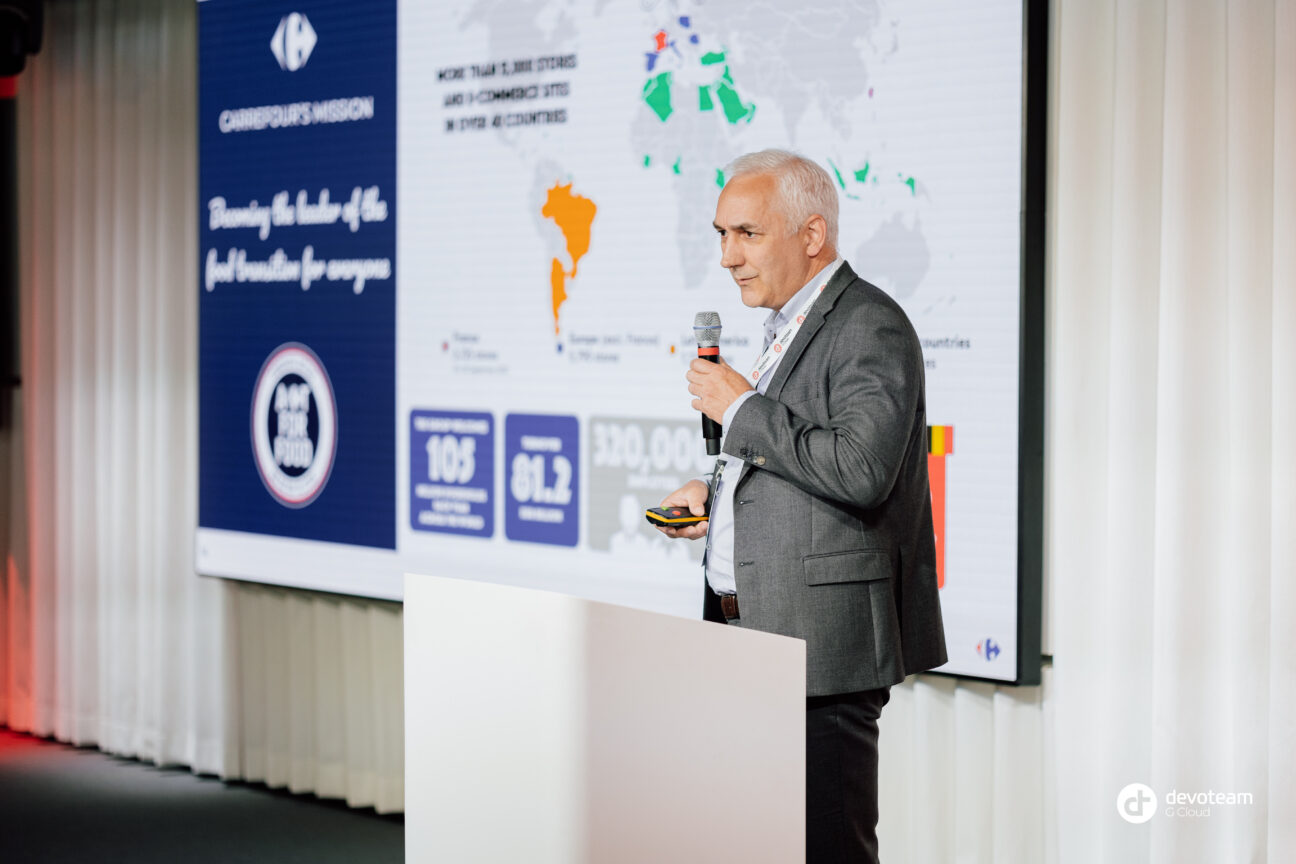Introduction
On the 6th of June during the Devoteam G Cloud Day, hosted at Google Brussels, the head of enterprise architects over at Carrefour, Peter Winkelmans, hosted an inspiring session to share his valuable insights on driving business growth through cloud infrastructure. Peter has played a key role in the implementation and adoption of cloud services at his company, his vision of cloud-native technologies is shaping the Carrefour landscape. He is a frontrunner in these technologies and is pushing new and innovative ideas. In this talk he presents what Carrefour envisions with this technology, the process of transformation, and the strategies that will be made possible thanks to the technology.
Streamlining Processes
Carrefour, operating in 30 countries, had historically utilised disparate technologies and methods, leading to inefficiencies. However, recent advancements allow them to bring these technologies together, streamlining processes, and gaining a comprehensive overview of their operations through the Google environment. This unified approach is possible by leveraging one of the largest databases in Europe, where all information integrates.
Implementing new technology is relatively easy, but transforming both technologies and mindsets is a more complex endeavour. Carrefour recognises the need to reinvent its organisation, adapt to new technologies, and transition its applications to become purely cloud-native. To achieve this, they identified and addressed 23 pain points, to optimise costs, speed, and trust throughout the transformation process.
Of course, Carrefour did not embark on this transformation alone; instead, they forged a collaborative partnership with Google and Devoteam G Cloud. This collaboration enables them to leverage the expertise and resources of these experienced partners. Carrefour’s digitalisation journey encompassed six differentiators across three levels: infrastructure, application, and security.
The 6 Differentiators of the IT Digitalisation Journey
Carrefour aimed to use Google to optimise the organisation on 3 levels:Infrastructure, Application, and Security.
Infrastructure Level
Carrefour aimed to optimise its organisation by moving from physical servers to serverless architectures. They also embraced DevOps practices, shifted from batch to real-time processing, and automated deployment and testing processes. This transformation allows them to reduce operational complexities and enhance scalability.
Application Level
Carrefour focused on transitioning from monolithic to microservices architecture, adopting a service-oriented architecture approach, and moving from scheduled to real-time processes at the application level. By breaking down their applications into smaller, modular components, they improved flexibility, agility, and the ability to scale individual services.
Security Level
To ensure security, Carrefour incorporated a zero-trust model, granting access based on user identity and context. They also shifted control from the network to the application layer, enhancing security measures. This approach provided granular control over access rights, reducing the potential attack surface and increasing data protection.
How did they do it?
Carrefour’s transformation journey involved two distinct cloud environments: “Google V1” (internal name) for Infrastructure as a Service (IaaS) and “Google V2” for Platform as a Service (PaaS) and application transformation. Understanding both environments was crucial for maximising the benefits offered by Google Cloud and tailoring their approach based on team maturity and differences. It allowed Carrefour to optimise resource allocation and leverage specific capabilities of each environment.
The Six-Layered Design
Carrefour adopted a four-layered open platform strategy, which evolved into a six-layered design. This design included the front layer (Application/Presentation layer), API layer, Back-Office Layer/Data Insight layer, Data layer, Data API layer/ETI layer, and SAP. Each layer has a crucial role in supporting their business processes, data management, and integration efforts.
Buy versus Build
Traditionally, Carrefour would opt to buy expensive software solutions. However, they realised that building custom solutions using low-code platforms could provide similar time-to-market and greater efficiency. By developing personalised solutions aligning with their organisation’s needs, Carrefour achieved better integration with core functionalities and experienced performance gains. Additionally, building custom solutions allowed them to avoid being constrained by pre-packaged software that may not meet their requirements.
Final Lessons and Recommendations
Through the transformation journey, Carrefour learned valuable lessons that can guide other organisations on similar digital transformations. It became evident that technology alone is not the key to success; it’s the vision, the team, the training, and the culture driving successful transformation. Besides that, Peter Winkelmans highlighted the following points:
- Communication is the essential component, having a clear vision, and looking in the same direction.
- Experienced partners are needed to guide you on your journey.
- Coaching and training are essential to have a cloud-driven mindset.
- Start with a team outside your organisation, get a fresh perspective and gain new insights.
- Two key problems:
- Knowledge, you do not always have as much as you need
- Resistance to change and innovation.

Elevate Your Cloud Infrastructure
Carrefour’s journey of digital transformation through cloud infrastructure serves as an inspiring example for businesses looking to drive growth and innovation. Are you ready for the next step in your Cloud Infrastructure Journey?